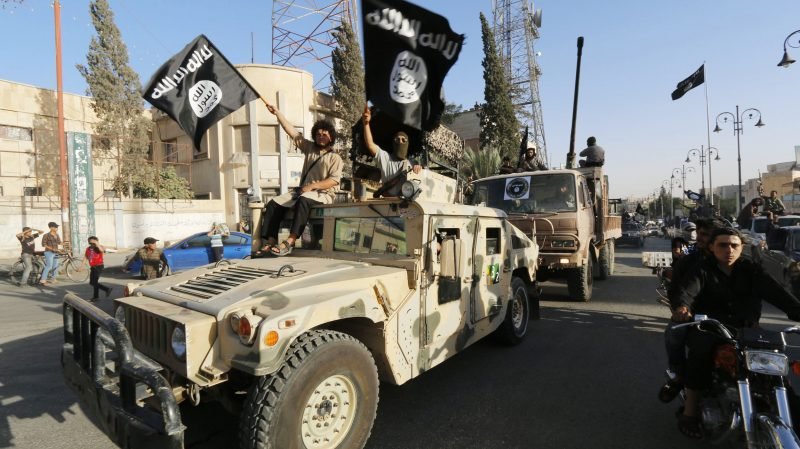The Resurgence of IS in Iraq and Syria

The resurgence of the Islamic State (IS) in Iraq and Syria is predominantly composed of Saddam Hussein’s militants, not new recruits. Former Iraqi officers who were led by Hussein allegedly continue to dominate the organization’s hegemony. Their ingrained warfare expertise is fundamental to the survival and growth of IS in today’s political and socio-economical stance. The Iraqi officer command and control IS, centring its tactics and plans in its rooted history. The implications of the composition of the organization’s structure are that the Islamic State is organic to Iraq because of its history in warfare. Because a remarkable amount of locals in Iraq and Syria now loath IS, due to the accumulated damage it caused in their nations, the former Hussein officers have altered their recruitment methods to foreign volunteers (The Washington Post, 04 April 2015). The influx of foreign fighters has become instrumental to the organization’s survival in Iraq and Syria since they have minimal support from the public. Correspondingly, global affairs like the Iran-U.S. tension, Turkish intervention in Syria, and the COVID-19 pandemic have distracted the Iraqi and Syrian government from controlling the resurgence of IS.
Moreover, the Iraqi people are more concerned with the arrival of a new form of a terrorist organization. Soleimani’s death has unified Iraq’s rebel popular mobilization force, which initially raised the battleground force against ISIS since battlefront days. Several months after the fall of ISIS, thousands of Iraqis gathered on the street to protest the corrupt government officials and increasing Iran’s dominance in the country. This chaos among the general public can be harnessed to resurrect the ISIS footprint or some new terrorist outfit supported by regional non-state actors like al-Qaeda and Boko haram (TIME, 08 January 2020). Naqshbandi and smaller groups of Saddam-era officers made up most fighters in the initial stages. A different group of such officials working behind the jihadist and creating chaos to resurge the ground force. The main reason being the Baath’s party was dissolved, and its officials were debarred from joining a new security service by the USA. Some left the country; others joined the anti-American insurgency. However, not all Baathists are supporting jihadists, and there is a difference, some supporting IS, some are opposing( REUTERS, 11 December 2015)

Rising Tensions between Iran and U.S.
The ascension of conflict between Iran and the U.S. inadvertently aided IS growth and presence in Iraq. The January 2020 assassination of Iranian General Qassem Soleimani, by the United States, further strained the relationship between the two nations. It sparked a controversy in Iran over the legality of the act; Iran perceived it as an act of state terrorism. The lack of evidence from the U.S. on its justification that Soleimani was planning attacks that jeopardized American lives exacerbates the controversy. The assassination directly impacted the fight against IS in Iraq because the deputy commander of Iraq’s Popular Mobilization Forces (PMF), Abu Mahdi Al Muhandis, was consequently killed in the same U.S. airstrike that killed Soleimani. Muhandis’ influential stance in the fight against IS was pivotal for the Iraqi success in producing countermeasures; he was one of the most important military leaders.
The aftermath of the Soleimani and Muhandis assassinations is two-fold: Iraqi forces reduced after the mandated withdrawal of U.S. troops and U.S. military forces shifted efforts to their conflict with Iran. The assassination of Soleimani elicited removal of U.S. troops in Iraq due to fear of being targeted for a battleground between Iran and the U.S. The current lack of U.S. military presence in Iraq increases the country’s vulnerability and capacity to fight against IS. The terrorist organization may see this arrangement as an opportunity to overpower the Iraqi forces, whose strength is far less without U.S. support. Subsequently, the rising tensions with Iran have drawn the U.S. to displace efforts from countering IS to supporting its troops in potential Iranian attacks. The distraction from the Iran-U.S. conflict enables IS to regroup and strengthen its efforts to exist in the Middle East by virtue of neglect.
The battle against ISIS created a wartime alliance between the USA and Iran. The Americans are fighting with their massive firepower while Iran is fighting with its ability to penetrate deep into the Iraqi communities. However, the alliance is not formally proven, and it is not clear how closely they cooperated. “The war against ISIS was America in the air and God on the ground,” says Mowaffak al-Rubaie, a former Iraqi National Security Advisor, referring wryly to the Shia militia as “God;”. Shia worldwide follows the orders from clerics in Iran, and any voice from clerics is seen as the order from the highest authority. The rising conflicts between the two nations are due first, Iran’s flattering nuclear deal, and recently, the killing of general Soleimani leaks this unofficial alliance against ISIS.

Syrian Civil War & Turkish Interference
Turkey’s recent interposition in Northeast Syria disrupts the nation’s stability to retrieve its lost territory from the Syrian civil war. Its intervention has inadvertently stirred more violence between jihadi groups surrounding regional borders in Syria. Most prominent is the Islamic State’s initiative to regroup in Syria, due to the Syrian Democratic Forces (SDF) diversion of IS to resist Turkey. With prioritization on resisting Turkish forces, IS is granted the freedom to maneuver and plan operations. In the last three months of 2019, SDF was predominantly occupied by Turkey’s invasion in Syria’s Kurdish territory, which led to a mere four percent of overall attention to IS. Thus, IS is exploiting the Syrian-Turkish conflict to create more disorder. Their goal is to further weaken the SDF by terrorizing citizens into disobeying local authorities (International Crisis Group, 26 May 2020). The foregoing distrust for the SDF, due to the intentional exclusion of local leaders in decision-making, advances IS disruption in creating civil unrest. The public distaste for the SDF facilitates IS endeavors to strengthen the level of chaos in Syria, which may distract intelligence agents from creating counterterrorism measures.
The turkey intervention is further complicating the issue as it is fighting the Syrian army backed by Iran and Russia. The US formally supported the Turkish move, but the European Union feared another refugee crisis in the region. The turkey is already under domestic pressure due to a massive influx of refugees. A Turkish army’s retaliation bounds any deliberate action by the Syrian military to gain lost territory along the turkey border. Erdoğan had intensified his rhetoric against the Syrian regime, threatening to intervene if Assad did not curtail his offensive. The major player in the region is again creating the room for a possible resurgence of IS. Erdoğan’s domestic policy to revive the Islamic culture in Turkey is adding fuel to an already burning region( Vox, 02 March 2020)
COVID-19
The global effects from COVID-19 deepen the challenges that failed states face in controlling law and order. In Syria, the SDF is already stretched thin in resourcing resistance towards Turkish forces and recuperating territorial effects from the aftermath of the civil war. COVID-19 adds more stress, attention, and requirements to control a nation that is currently on the brink of collapse. Idlib, the last fortress of Syrian rebels and jihadists, is overpopulated because of Russia’s offensive tactic to contain the rebels. In turn, worrisome civilians are crowding at the Turkish border out of fear of Russian operations. This fleet has created an overpopulated roadblock that directly violates the Centers for Disease Control and Prevention (CDC) recommendations. Movements sparked by the Turkish-Russian conflict in Syria have become detrimental to the health care sector. They must react to the pandemic outbreaks, caused by the lack of social distancing in large areas of Syria, with limited resources and medical supplies. The pandemic crisis in Syria adds another stressor to their government, in addition to the existing political dilemma with Turkey.
The Iraqi government is also shriveled by the pandemic’s strain on resources. COVID-19 is corroding Iraq’s capability of acting on anti-IS efforts. IS is exploiting this unprecedented interruption through propaganda, announcing that this is the ideal time to wage global war (Armed Conflict Location & Event Data Project, 24 July 2020). They are globally publicizing the opportunities that COVID-19 has induced; jihadists must exploit the disorder of overloaded weak nations. IS is taking advantage of the health crisis to wreak havoc in the Middle East because they know governments are under pressure to control the outbreak. Furthermore, European allies are removing troops from Iraq because of the pandemic to avoid contagion. The coalition between Middle Eastern and Western states is deteriorating at a time when Iraq is struggling with multiple conflicts. The withdrawal of ally presence in Iraq weakens anti-IS efforts because of the government’s limited position to handle COVID-19 and political unrest.

Countermeasures
Although IS does not have the power it did during its peak in 2014, the group has longevity in experience of catering to emerging political and economic conflicts in the Middle East. The large discontent towards the group has been detrimental to their manpower, finances, and hegemony. However, remnants of the Hussein regime have influenced the resurgence of IS in Iraq and Syria today. The overwhelming political and socio-economic crises in Iraq and Syria have stimulated jihadi reconsolidation and growth. It has given IS the time and freedom to reorganize in a way that would grant them more power, during a time that would otherwise seem impossible. The group may not currently have the capacity to become the most powerful terrorist group in the Middle East, but its intrinsic skills and knowledge may help them fulfill their goals soon. Its trajectory and perseverance through recent violent activity indicates that they will not be easily defeated. Between 2019 and 2020, IS significantly increased their consistency of aggressive attacks since their defeat in 2017 (Armed Conflict Location & Event Data Project, 24 July 2020). The correlation between recent conflicts in Iraq and Syria and increased jihadi violence indicates that these governments must learn to balance their responses to versatile matters.
With respect to Syria, the SDF must prioritize anti-IS efforts and not entirely devote efforts on Turkey. Diplomatic pressure must be appointed to Kurdish and Turkish partners so that they can accord on the conflict in Northeastern Syria. This truce would create temporary peace in the front lines of Syria, thus enabling the SDF to balance their fight against IS and the COVID-19 pandemic. Furthermore, foreign allies should assist Syria in stabilizing its regions through a civilian-military approach. They could implement incentives for the SDF to delegate power to local authorities in becoming the security services main effort. This approach could hinder IS from exploiting anti-SDF and anti-Kurdish resentment from the local populace, which would destroy their strategy aforementioned.
The U.S. must reconsider its actions towards Iran because it is affecting Iraqi forces as well. With the U.S. being the dominant force in the coalition against IS, their distraction towards Iran is detrimental to Iraq’s success in counterterrorism. Although tensions are already high, the U.S. should implement a truce with Iran before attacks escalate into a full-blown war. If they can create a peace agreement with Iran, Iraq will no longer be afraid to have U.S. troops on ground. The coalition between foreign allies and Iraq is essential to strengthen forces against IS; it may discourage IS from thriving for power in the nation. External support can also alleviate time, efforts, and resources that are being used for other national dilemmas. Iraq could then continue its efforts to counter jihadi threat before it worsens.


















